
FEBRUARY2007
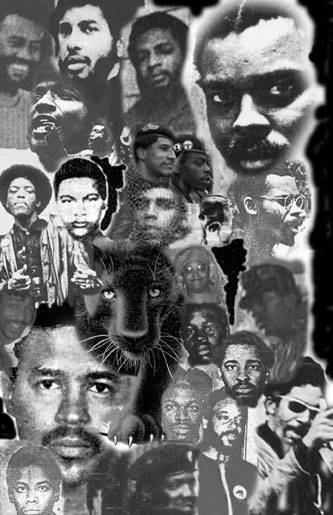 Workers
World - Feb 8, 2007 issue
Workers
World - Feb 8, 2007 issue
http://www.workers.org/2007/us/panthers-0208/
A Tribute to the
Black Panther Party
By Larry Hales
Oakland is one of the poorest cities in California as
well as the entire country. It holds the dubious
distinction of having been dubbed the second most violent
city in California after Compton, near Los Angeles. Both
cities are predominately communities of color, primarily
Black and Latin@
people.
Oakland has a poverty rate of over 18 percent; 27.9
percent of its youth under 18 live below the poverty
line. In Compton the poverty rate is much higher. The per
capita yearly income in 2000 was $10,389, with 28 percent
of the population living below the poverty line; 35.6
percent of youth
under 18 live below the poverty line.
Crime heavily affects both cities. Both areas are
impoverished and the residents of color suffer from
police repression, occupation and brutality. The
"answer" given to the conditions from which
despair arises is not different from what is happening in
inner city areas across the country, where the poor and
people of color have lived since "white flight"
began over 30 years ago.
That "answer" is to build luxury homes and
condos, retail shops and other amenities that tailor to
middle-and upper-middle class whites who want to move
back into the city centers. Poor people and people of
color are pushed to the fringes of metropolitan areas in
a "liberal" form of ethnic
cleansing.
Oakland, of course, has a rich history of struggle. It
conjures up in the minds of most Black people 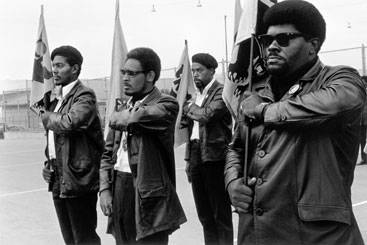 an era of
great militancy and revolution--when the realities of
ghetto life, of the Vietnam War's toll on the whole
country and the national liberation and revolutionary
movements around the world contributed to the rising
fervor in the U.S.
an era of
great militancy and revolution--when the realities of
ghetto life, of the Vietnam War's toll on the whole
country and the national liberation and revolutionary
movements around the world contributed to the rising
fervor in the U.S.
The Black Panther Party for Self-Defense, founded in 1966
in Oakland, was a group so dangerous to the U.S. ruling
class that FBI chief J. Edgar Hoover labeled it "the
greatest threat to the internal security of the United
States."
The BPP was a vanguard organization fighting for
self-determination for the Black nation in the U.S., but
evolved over its short existence to adopt a thoroughgoing
anti-imperialism, as a way for humanity to free itself
from the cycles of war and oppression.
The founding document of the BPP was the Ten Point
Platform and Program, which stated as the first desire
and goal:
o We want freedom. We want power to determine the destiny
of our Black Community. And,
o We believe that Black people will not be free until we
are able to determine our destiny.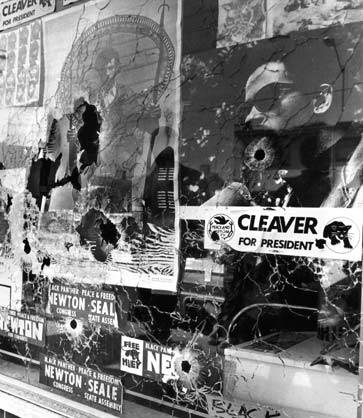
The Ten Point Platform and Program also called for
"land, bread, housing, education, clothing, justice
and peace" and wanted exemption of Black people from
military service that used Black people to "fight
and kill other people of color in the world who, like
Black people, are being victimized by the white racist
government of America."
Rebellions and survival programs
The BPP was founded by the great revolutionary leaders
Huey P. Newton and Bobby Seale and was initially
established to expose and fight against police brutality
in Oakland.
By 1967 there had been over 100 rebellions in cities
across the U.S. Many took place in some of the poorest,
most oppressed and repressed cities. The rebellions were
an outgrowth of the social conditions and the many
contradictions rooted in capitalist society. The
antagonisms that exist between the rulers and the workers
and nationally oppressed were being displayed.
The BPP was partly molded after the Deacons for Defense
and the armed self-determination struggle opened up by
the great revolutionary Robert F. Williams, in that it
asserted the right of the oppressed to defend themselves
with arms against the oppressor.
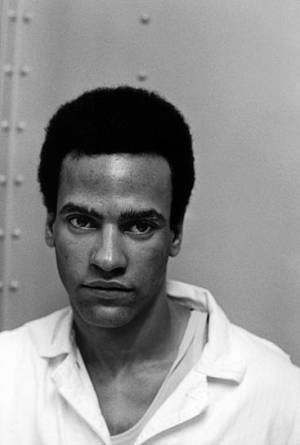 Huey
P. Newton would call attention to the fact that the
Vietnamese people and the Black masses were fighting the
same oppressor and that the struggles of the two were
linked.
Huey
P. Newton would call attention to the fact that the
Vietnamese people and the Black masses were fighting the
same oppressor and that the struggles of the two were
linked.
Many organizations that mirrored the sentiment of the BPP
began to develop from other oppressed nationalities, like
the Latin@-based Young Lords. Support groups of the BPP
were formed by white revolutionaries and other Panther
allies.
The groups that mirrored the Panthers were not simply
attracted to the militancy of the Panthers. They took
inspiration from the many programs established by the BPP
to look after the health and well-being of Black
communities, such as the free breakfast program.
There were 35 such initiatives and they came to be known
as survival programs. They were not attempts to reform
the system, but examples of what is possible for
humanity. They were humane programs and necessary
alternatives to the system, as the government of the
capitalist rulers did not provide these services.
The programs were of great pride in the communities in
which they flourished and were provided for under the
slogan "survival pending revolution." Some
would denigrate the Panthers for organizing these
programs, not understanding that the immediate needs of
the people had to be met while fighting for revolutionary
change.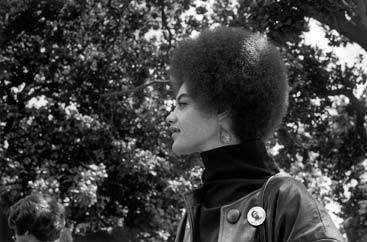
The Free Breakfast for Children Program fed thousands.
The federal government eventually co-opted the idea,
while attacking the Black Panther Party's program as
being a communist agenda. While capitalist propaganda
made communism out to be the great evil, imperialist
aggression, an objective outgrowth of capitalism,
inflamed the whole world and rained down bombs, death and
destruction from Oakland to Southeast Asia.Pirkle Jones, Kathleen
Cleaver, Communications Secretary of the Black Panther
Party and wife of Eldridge Cleaver, DeFremery Park,
Oakland, July 14, 1968
Eventually, the brutal assault of the federal government
broke the back of the BPP. Members were hunted down,
framed up and imprisoned, and systematically
assassinated.
The FBI created Cointelpro, an insidious program
contrived to destroy national liberation and civil rights
movements in the U.S., socialist and communist parties
and anti-war groups. One of its main targets was the
Black Panther Party.
Cointelpro was used to infiltrate the Panthers, pit
members against one another, bribe, cajole, plant
evidence and use every mechanism under the sun to keep
the U.S. rulers' tenuous stranglehold on workers and the
oppressed from being cast off.
It is believed by many that the FBI also introduced
heroin into Black communities, not far-fetched
considering the toll the drug took on oppressed
communities.
Though the original BPP no longer exists, its history
provides lessons and examples for today's struggle. The
U.S. capitalist rulers have become more militarily
adventuristic abroad and conditions of life are becoming
more intolerable for the masses at home.
What will give the movements of the workers and the
oppressed a boost of energy and deepen the people's
understanding of the intransigent antagonism of a common
enemy? It is the theory of what is possible when the
workers seize real power, based on the theories of Karl
Marx and Vladimir Lenin along with other great socialist
revolutionaries and national liberation fighters.
And, for the oppressed Black nation, a shining example
was the heroic Black Panther Party for Self Defense.
***
Workers World - Feb 8, 2007 issue
http://www.workers.org/2007/us/sf-panthers-0208/
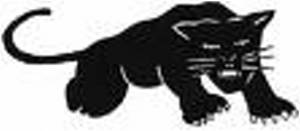
San Francisco Rally
supports arrested Panthers
By Judy Greenspan
San Francisco
On the same day that U.S. Attorney General Alberto
Gonzales announced that people do not have a
constitutional right to challenge their imprisonment,
eight former Black Panther Party leaders and community
activists were indicted for something that happened over
35 years ago--the killing of a San Francisco policeman.
But if a Jan. 28 support rally is any indication, the Bay
Area progressive community will not tolerate this
outrageous attack on the Black liberation movement.
On Jan. 23, after a two-year witch hunt by local, state
and federal police, six former Bay Area Black Panther
Party organizers were arrested: Richard Brown, Richard
O'Neal, Francisco Torres, Ray Boudreaux, Hank Jones and
Harold Taylor.
Two well-known political prisoners, Herman Bell and Jalil
Muntaqin (Anthony Bottom), part of the New York Three who
were falsely accused and convicted of killing two New
York City policemen, have also been accused and indicted.
John Bowman, the ninth target of the two-year-long grand
jury witch hunt, died in December.
Why did the government indict this group of Black freedom
fighters now? Why has the government relentlessly pursued
these activists more than 35 years after the alleged
"crime" was committed?
On Jan. 28 a local activist media collective, Freedom
Archives, premiered their latest exposé of racism and
injustice in this country, "Legacy of Torture: The
War Against the Black Liberation Movement." The new
DVD documents the torture of several of the arrested
activists--Bowman, Jones, and Taylor--at the hands of the
New Orleans Police Department in 1973.
Several of the men were incarcerated for refusing to
testify before a grand jury. The video also captures the
level of police brutality, assassinations and abuse
suffered by the Black community during the 1960s and
1970s.
According to the Committee for the Defense of Human
Rights (CDHR), a group devoted to exposing human rights
abuses against progressive organizations and individuals,
13 Black activists were arrested in New Orleans in 1973
and tortured for several days in a manner similar to
today's torture at Guantánamo Bay and Iraq's Abu Ghraib.
In "Legacy of Torture," Bowman, Jones and
Taylor graphically describe being stripped naked and
beaten by slapjacks and blunt objects; probed by cattle
prods in their genital areas; and nearly suffocated by
plastic bags being placed over their heads and wet wool
blankets wrapped tightly around their bodies.
The government failed in the early 1970s to bring any of
these men to trial for the killing of San Francisco
policeman John Young. In fact, California courts deemed
all the coerced false confessions from New Orleans
inadmissible due to the physical abuse and torture
suffered by the men.
Brown, who has spent the last 30 years working with young
people in this city's African-American community,
denounced the government's violence against the Black
liberation movement in an interview with the SF Bay View
newspaper. "I was named as a participant in 1971 in
the murder case. All Panthers were targeted. If we were
doing something constructive, we were singled out. They
killed Bunchy Carter, arrested and imprisoned Geronimo
[Pratt]. It was just our turn. We were next on the
list," Brown stated.
Soffiyah Elijah, a New York-based attorney who has
defended many Black freedom fighters, spoke briefly at
today's program, which drew so many people to the Roxie
Theater that the film had to be shown twice. "In the
wake of 9/11 and the Patriot Act, the government is now
resurrecting its Cointelpro actions. Homeland Security is
merely an extension of that effort," Elijah said.
Cointelpro was the domestic government program used to
undermine, disrupt and assassinate the leadership of
domestic liberation movements, revolutionary
organizations and progressive groups in this country that
were protesting government policies in the 1960s and
1970s.
John Bowman says in "Legacy of Torture," now
dedicated to his memory: "I am sick of these people
trying to destroy our community." The support at
today's program echoed this sentiment as hundreds of
people signed up to become involved in the defense
effort.
A large crowd attended John Bowman's memorial at the
African American Art and Culture Complex following the
film showing. A bail hearing for the imprisoned Black
activists is scheduled.
For more information about how to support these activists
or purchase a
copy of the new video, write to cdhrsupport@freedomarchives.org or visit
http://www.freedomarchives.org. "Legacy of Torture" is
available at
http://www.leftbooks.com.
Articles copyright 1995-2007 Workers World. Verbatim
copying and
distribution of this entire article is permitted in any
medium without
royalty provided this notice is preserved.
Workers World, 55 W. 17 St., NY, NY 10011
Email: ww@workers.org
Subscribe wwnews-subscribe@workersworld.net
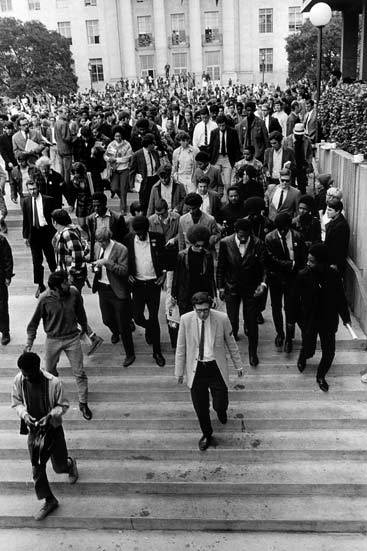
1968
Pirkle Jones, Eldridge and Kathleen Cleaver leaving, University of California, Berkeley, October 3, 1968
This is October 3rd. This is the end of this rally, and here we are pouring out. (Pointing to people near top of steps) That's Eldridge; that's me; this is Emory Douglas, artist; David Major; Gail Bell; some people know Stu Albert; Judy Albert. It was quite a crew here. All those people you saw pouring out into the streets in October really were filled with a sense of hope and purpose and determination.